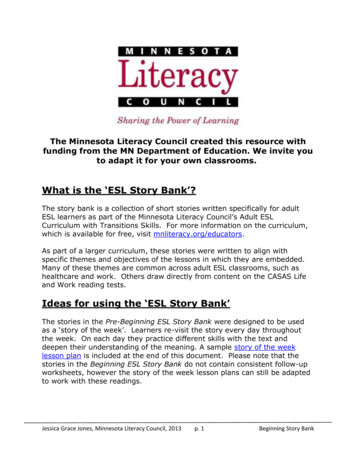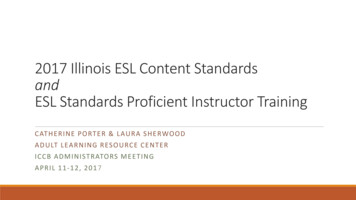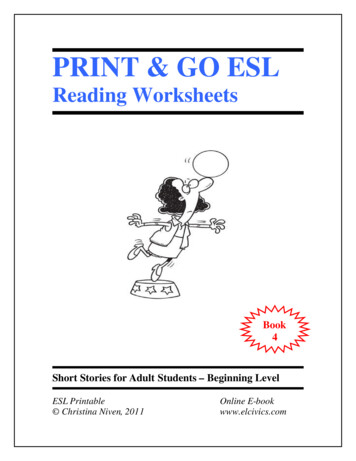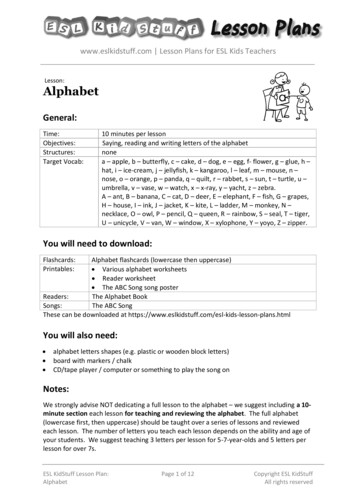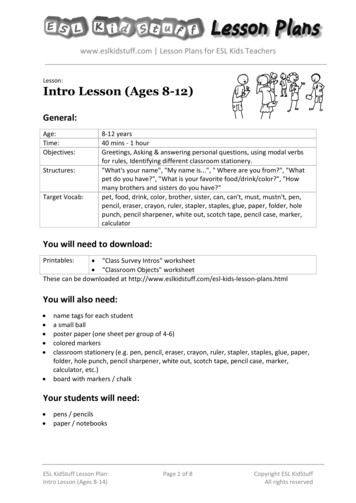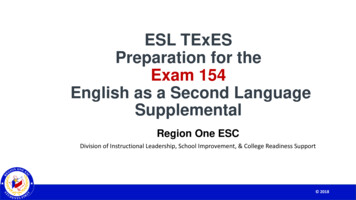
Transcription
ESL TExESPreparation for theExam 154English as a Second LanguageSupplementalRegion One ESCDivision of Instructional Leadership, School Improvement, & College Readiness Support 2018
Professional Learning Essential Agreements Be Respectful of others Be an Active participant Take Care of your needs Use electronic devices as Learning Tools 2018 REGION ONE EDUCATION SERVICECENTER 2018
Purpose: This informative session is designed to help Texaseducators prepare for the ESL TExES #154Objectives Content Objective:Today I will explore knowledge aligned to the ESL TExESDomains, Competencies, and test design. Language Objective:Today I will discuss new knowledge regarding researchbased instructional practices for English LanguageLearners aligned to the ESL TExES. 2018 REGION ONE EDUCATION SERVICECENTER 2018
Quiet Signals 2018 REGION ONE EDUCATION SERVICECENTER 2018
r 2018 REGION ONE EDUCATION SERVICECENTER 2018
2018 REGION ONE EDUCATION SERVICECENTER 2018
Test Taking Tips and StrategiesYou have 5 hours to take the test!› Identify and know the key words included in the manual. Visualize the scenario.› Know the terminology, to answer correctly.› “Perfect educational context” (cooperative learning, differentiatedinstruction, etc.)› Do not consider your own experiences.› Think of the ELL with other language background as well(Vietnamese is 2nd largest group in TX). 2018 REGION ONE EDUCATION SERVICECENTER 2018
Resources ETS Website: http://cms.texes-ets.org/texes/ ESL Manual: l.pdf Articles: language transfer, culturally relevant texts, biliteracy, court cases,LPAC, Chapter 89, etc. Smore: https://www.smore.com/d2fbk-154-esl-texes?ref my Review and Study 2018 REGION ONE EDUCATION SERVICECENTER 2018
Resourceshttp://bit.do/dretesltexes 2018 REGION ONE EDUCATION SERVICECENTER 2018
What I See, What I hear What do you see, what do you hear in aneffective ESL classroom?I see I hear 2018 REGION ONE EDUCATION SERVICECENTER 2018
Important Acronyms– LEP Limited English Proficient– L1 native language– L2 second language– ESL English as a second language– ESOL English speakers of other languages– SI Sheltered instruction– SIOP Sheltered Instruction Observation Protocol 2018 REGION ONE EDUCATION SERVICECENTER 2018
About the TestEnglish as a Second Language Supplemental154Language Conceptsand AcquisitionsESL Instruction andAssessment 2018 REGION ONE EDUCATION SERVICECENTERESL Education 2018
ESL TExESThe test contains: 80 multiple-choice questions in 5 Hours May contain questions that do not count toward score Single or clustered questions Final scaled score is based on scored questions 2018 REGION ONE EDUCATION SERVICECENTER 2018
Question Formats› Multiple-choice› Single: direct questions or incomplete sentence.› Clustered: consists of stimulus and questions. Stimulus cab be a readingpassage, description of an experiment, graphic, table or any otherinformation necessary to answer the questions.› Unfamiliar question formats› May include audio or video stimulus› Interactive questions 2018 REGION ONE EDUCATION SERVICECENTER 2018
ESL TExES nDescriptorCompetencyDescriptor 2018 REGION ONE EDUCATION SERVICECENTER 2018
The StandardsStandard I: The ESL teacher understands fundamentallanguage concepts and knows the structure andconventions of the English language.Standard II: The ESL teacher has knowledge of thefoundations of ESL education and factors thatcontribute to and effective multicultural and multilinguallearning environment. 2018 REGION ONE EDUCATION SERVICECENTER 2018
The StandardsStandard III: The ESL teacher understands theprocesses of first- and second -language acquisitionand uses this knowledge to promote students’ languagedevelopment in English.Standard IV: The ESL teacher understands ESLteaching methods and uses this knowledge to plan andimplement effective, developmentally appropriate ESLinstruction.Standard V: The ESL teacher has knowledge offactors that affect ESL students’ academic content,language and culture. 2018 REGION ONE EDUCATION SERVICECENTER 2018
The StandardsStandard VI: The ESL teacher understands formaland informal assessment procedures andinstruments (language proficiency and academicachievement) used in ESL programs and usesassessment results to plan and adapt instruction.Standard VII: The ESL teacher knows how to serveand advocate for ESL students and facilitate familyand community involvement in their education. 2018 REGION ONE EDUCATION SERVICECENTER 2018
ESL TExES FrameworkDomain I – LanguageConcepts and LanguageAcquisitionComposition of Test by Domain25%30%Domain IDomain IIDomain II – ESLInstruction and AssessmentDomain III45%Domain III – Foundationsof ESL Education,Cultural, Awareness andFamily and CommunityInvolvementTexas Examinations of Educator Standards 154. (n.d.). Retrieved 54 esl supppdf 2018 REGION ONE EDUCATION SERVICECENTER 2018
Domain I: Language Conceptsand Language Acquisition 2018 REGION ONE EDUCATION SERVICECENTER 2018
Basic Concepts of Language Systems Phoneme:The smallest unit of sound in a language. Phonology:The study of the sound system of a language. Morpheme:cars)The smallest unit of meaning in a language (word or unit – prefix re in redo, s in Morphology: The study of how morphemes develop words Syntax:The order in which words occur in a sentence. Semantics:The meaning attached to a linguistic unit (word or phrase) Pragmatics:The proper use of a certain type of language for a given situation. Lexicon:The vocabulary of an individual or topic. Discourse:Interchange of language between speakers. 2018 REGION ONE EDUCATION SERVICECENTER 2018
Phonology› Phonology is the system of relationships among speechsoundsIn the classroom:Plan activities to build phonological awareness through rhymes, blending, andsegmenting.Progress from easier to more difficult tasks by building on what studentsknow. 2018 REGION ONE EDUCATION SERVICECENTER 2018
PhonemesWordscatcolonelNumber of Phonemes35Teach the relationship between sounds and letters throughphonics: Say the word out loud to focus on the sounds ratherthan looking at the printed letters. Example: Son - /C/ /a/ /n/.Counting phonemes is difficult for an EL because many of thesounds in English do not exist in Spanish. 2018 REGION ONE EDUCATION SERVICECENTER 2018
Practice test question› If a student can not hear/learn initial sounds in some wordsbecause those sounds do not exist in his/native language,what do we need to teach him? 2018 REGION ONE EDUCATION SERVICECENTER 2018
Paired Verbal Fluency Find a partner. Low heel shares first while High heel listens. 2018 REGION ONE EDUCATION SERVICECENTER 2018
Morphology Morphemes- unit of a language that cannot be further divided.In the classroom:Focus on English morphemes that are useful to know because they occur mostfrequently.Help students discover patters through multisensory, multimodal experiences. 2018 REGION ONE EDUCATION SERVICECENTER 2018
SyntaxCompoundSentencesComplexSentencesTwo independent clauses that are joined with a conjunctions such as or,and, but.One independent clause an one or more dependent clauses.In the classroom: Discuss English syntax in the context of real reading and writing. Model how to break long sentences into chunks, interpret chunks, and then sumup the main idea. 2018 REGION ONE EDUCATION SERVICECENTER 2018
English sesAdjectivesAdverbsDirect &IndirectObjectsSubject andVerbAgreement 2018 REGION ONE EDUCATION SERVICECENTER 2018
Language ActivityWrite down what you did this summer to recharge.Example:I went to the island and woke up two weeks later. I had the bestsummer. 2018 REGION ONE EDUCATION SERVICECENTER 2018
Language Interference in PhonologyLanguage interferences bound with first language influence.-ELs tend to add an /e/ sound to the lettercombinations /esc/, /esp/Ex: Eschool vs. SchoolInterferences may exist by translation from mother tongue intoanother language- False cognatesEx. She choke with another car. 2018 REGION ONE EDUCATION SERVICECENTER 2018
Communicative CompetenceStrategicLinguistic-overcome language gaps.-Vocabulary-conversational fluency.-Language Conventions (grammar, spelling).-effectiveness of communication-Syntax-modify text for audience and purpose.Socio-Linguistic-Nonverbal behaviorsDiscourse-Cultural refences (idioms, expressions)-patterns of organization-Social rules of language-cohesive and transitional devices 2018 REGION ONE EDUCATION SERVICECENTER 2018
Structure of English Language - VerbsLink grammatical subject to adjective.LinkingDinner tastes as great as it looks.PrincipalHave a noun attached to them and can stand alone.Jesus wept.Describe a state of being rather than an action.StativeI have a car.Used with other verbs to express necessity or possibility.ModalHe will come. 2018 REGION ONE EDUCATION SERVICECENTER 2018
Interrelatedness of Listening, Speaking,Reading, and Writing Holistic approach to language arts instruction Reading Writing Listening Speaking Use of culturally relevant materials. Research/connect familiar or related topics Cooperative grouping Paired and shared reading, read alouds, small group Pre-reading exercises, including vocabulary development “You have to read the world, before you can read the word” -Freire 2018 REGION ONE EDUCATION SERVICECENTER 2018
KAHOOT IT! 2018 REGION ONE EDUCATION SERVICECENTER 2018
2018 REGION ONE EDUCATION SERVICECENTER 2018
2018 REGION ONE EDUCATION SERVICECENTER 2018
2018 REGION ONE EDUCATION SERVICECENTER 2018
Social Language vs. Academic Language Separate UnderlyingProficiency (SUP)L1 Common UnderlyingProficiency (CUP) Cognitive Academic LanguageProficiencyL2CALPL1L2J. Cummins, 1981 2018 REGION ONE EDUCATION SERVICECENTER 2018
The Iceberg TheoryJ. Cummins, 1981BICSBasic InterpersonalCommunication Skills1-3 years5-7 yearsCALPCognitive Academic Language Proficiency 2018 REGION ONE EDUCATION SERVICECENTER 2018
Double Iceberg TheoryJ. Cummins, 1981BICS L21-3yearsBICS L11-3 yearsCALP L1 L25-7 years 2018 REGION ONE EDUCATION SERVICECENTER 2018
Cognitive words Academic Language ProficiencyIn otherBICS L1Basic InterpersonalCommunication SkillsBICS L2Basic InterpersonalCommunication SkillsCALPL1L2CALP TransferL1-L2 Cognitive Academic LanguageProficiencyJ. Cummins, 1981 2018 REGION ONE EDUCATION SERVICECENTER 2018
Cummins’ Quadrants: The Dimensions of LanguageCognitively Undemanding LanguageBICS Basic Interpersonal Communication SkillsSocial conversation(with gestures)Storytelling with propsContext-embedded languageSocial phone callNote left on the refrigeratorContext-reduced languageMath lesson (with manipulatives)Social studies lectureGeography lesson with mapsMultiple choice testCALP Cognitive Academic Language ProficiencyCognitively Demanding Language 2018 REGION ONE EDUCATION SERVICECENTER 2018
KrashenInput Hypothesis Krashen hypothesized on the primary importance on thecomprehensible input (CI) that language learners are exposed to. Understanding spoken and written language input is seen as the onlymechanism that results in the increase of underlying linguisticcompetence. Learning is seen to be heavily dependent on the mood of the learner,with learning being impaired if the learner is under stress or does notwant to learn the language, known as the affective filter. 2018 REGION ONE EDUCATION SERVICECENTER 2018
Cognitivist TheoryPiaget› Piaget often spoke about the relationship between cognitive development and languageskills.Piaget defined schemas as the basic building blocks of cognitive models to enable us to form amental representation of the world. The student must be exposed primarily to input that can behandled without difficulty. The input must be at the student's actual level of development.Source: Thompson, S. (2015). Jean Piaget’s theory on child language development. Retrieved s-theorychild-language-development-9170.html 2018 REGION ONE EDUCATION SERVICECENTER 2018
Social Interactionist TheoryLev Vygotsky’s› Explains language development emphasizing:– The role of social interactions in the construction of knowledge. He developed the concept Zone of Proximal Development to definethe difference between what a learner can do without help and what heor she can do with help.– 2018 REGION ONE EDUCATION SERVICECENTER 2018
Nativist TheoryNoam Chomsky Language acquisition depends upon an innate biological brainmechanism called Language Acquisition Device (LAD) Assumes that children are born with the ability to acquire alanguage, and it is easy for them to make sense of the wordsbecause they were exposed to speech at birth. Developed the theory of Universal Grammar, which states that there arebasic principles that are shared by all languages. 2018 REGION ONE EDUCATION SERVICECENTER 2018
Skinner’s Behaviorist Theory› It suggests that language is acquired through external stimuli(conditioning, association, imitation, and reinforcement), eliciting aninternal response, that leads to external responses. ExternalResponse InternalStimulus InternalstimuliReward› Learning a second language depends on reinforcement (an award ora praise given to students after producing of certain aspects of a secondlanguage.) 2018 REGION ONE EDUCATION SERVICECENTER 2018
Language Acquisition TheoriesGroup ActivityTheoristsTheoryJim CumminsIceberg theory/CUP and SUPStephen KrashenComprehensible Input, Affective FilterPiagetSchema, Assimilation, AccommodationLev VygotskyZone of Proximal DevelopmentNoam ChomskyLanguage Acquisition DeviceSkinnerStimulus, Reponses, Reward 2018 REGION ONE EDUCATION SERVICECENTER 2018
Conga Line!! 2018 REGION ONE EDUCATION SERVICECENTER 2018
How do the theories apply to the followingillustration? 2018 REGION ONE EDUCATION SERVICECENTER 2018
How do the theories apply to the followingillustration? 2018 REGION ONE EDUCATION SERVICECENTER 2018
How do the theories apply to the followingillustration? 2018 REGION ONE EDUCATION SERVICECENTER 2018
How do the theories apply to the followingillustration? 2018 REGION ONE EDUCATION SERVICECENTER 2018
Cognitive Processes Memorization: Vocabulary and structural patterns have to be acquired bymemory (3x more than a native speaker). Categorization: Students must develop an organizational pattern for the newlanguage (use of cognates). Generalization: Students have to be able to apply a concept to a new languagecontext (if car/cars, then dog/dogs). Metacognition: Students think about their own thinking and learning activities. 2018 REGION ONE EDUCATION SERVICECENTER 2018
KAHOOT IT! 2018 REGION ONE EDUCATION SERVICECENTER 2018
2018 REGION ONE EDUCATION SERVICECENTER 2018
2018 REGION ONE EDUCATION SERVICECENTER 2018
2018 REGION ONE EDUCATION SERVICECENTER 2018
Domain IIESL Instruction and Assessment 2018 REGION ONE EDUCATION SERVICECENTER 2018
ESL Methods and Techniques Audiolingual approach: Few minutes of repetition and practice to introduce language Total Physical Response (TPR): Approach for beginners using physical movement Total Response Signal: tool to determine student understanding. Natural Approach to ESL: Real-life communication (music, drama, visuals, realia) Sheltered InstructionVocabulary development prior to instructionVisuals, posters, films, maps, videos, background knowledgeCooperative learningStudy skills: Organizers, SQ3R, Thinking Maps 2018 REGION ONE EDUCATION SERVICECENTER 2018
The ESL teacher knows the TEKS and the ELPS and knows how to designlanguage and content objectives appropriately aligned to the crosscurricular student expectation standards.Pair reading, graphic organizers to facilitate understanding of structureof text and grammar,Allow Sara to use native language and drawing, give visual support,adapted text, modeling. 2018 REGION ONE EDUCATION SERVICECENTER 2018
What are ELPS?ELPS are federally required instructional standards designed to ensurethat EL acquire English proficiency.19 Texas Administrative CodeChapter 74. Curriculum Requirements Subchapter A. RequiredCurriculum 74.4 English Language Proficiency Standards (ELPS)Adopted December 2007 2018 REGION ONE EDUCATION SERVICECENTER 2018
ELPS: How they are organized . 2018 REGION ONE EDUCATION SERVICECENTER 2018
Developing Visual LiteracySTAARTELPAS 2018 REGION ONE EDUCATION SERVICECENTER 2018
TEKS vs. ELPS continued .Academic ProficiencyLanguage ProficiencySTAARTELPASTEKSELPSRelating Factor: evaluates/measures 2018 REGION ONE EDUCATION SERVICECENTER 2018
Writing Lesson for ELLs: Integrating TEKS & ELPSExplainPublish(Share)Pre-writeEditDraftRevise 2018 REGION ONE EDUCATION SERVICECENTERp.7 2018
ELPS-TELPAS Proficiency Level Descriptors The PLD’s describe how well ELLs at each proficiency level areable to understand and use English to engage in gradeappropriate academic instruction. 2018 REGION ONE EDUCATION SERVICECENTER 2018
TELPAS25%25%10%30%25%10%25%50% 2018 REGION ONE EDUCATION SERVICECENTER 2018
Compare and contrastBeginnerProvide sentencestarters to completesentences.SameAdvanced HighCreate their ownoriginal sentences byutilizing propersyntax and grammar.Both receive instruction on grade level. 2018 REGION ONE EDUCATION SERVICECENTER 2018
Inside Out Circle 2018 REGION ONE EDUCATION SERVICECENTER 2018
ESL Teaching MethodsShelteredInstructionVisualsLanguagethrough ContentCooperativegroupsScaffoldingTPR (totalphysicalresponse)TRS(total responsesignals)LanguageExperienceApproach (LEA) 2018 REGION ONE EDUCATION SERVICECENTER 2018
Learning Styles and Strategies Active learners: Understand information best by doing something active with it. Reflective learners: Think about it quietly first. Sensing learners: Like learning facts. Intuitive learners: Like discovering possibilities/relationships. Visual learners: Remember best when they see pictures, diagrams, flow charts, time lines, etc. Verbal learners: Get more out of words, written and spoken explanations. Sequential learners: Gain understanding in linear steps. Global learners: Learn in large jumps, absorbing material without seeing connections, and thensuddenly “getting it”. 2018 REGION ONE EDUCATION SERVICECENTER 2018
Paired Reading› Two read together from the text.› Students monitor reading.p.7 2018 REGION ONE EDUCATION SERVICECENTER 2018
Building WordsDevelop student's phonemic awareness, letter sound associations, commonEnglish phonograms, phonetically irregular words, high frequency words:› beginning sounds.› Ending sounds.› Medial vowel sounds.› Beginning blends.› Vowel diagraphs– ex: toad, fleet. 2018 REGION ONE EDUCATION SERVICECENTER 2018
Sight Word Activity Use hands on to introduce and or reinforce concepts. Pre-teach vocabulary and teach them to use words in sentences. Incorporate writing. 2018 REGION ONE EDUCATION SERVICECENTER 2018
Rhyming Word Activity1. Use word families.2. Hands on games.3. Using words in context.4. Write words with a rhyming pattern. 2018 REGION ONE EDUCATION SERVICECENTER 2018
Word Wall› Opportunities to usein writing.› Chants forinteractive learning.› Instant recognition incontext. 2018 REGION ONE EDUCATION SERVICECENTER 2018
Reader’s Theater It is a transferable skill that helps students acquire fluency.Select script or create one.Assign parts of the texts to each group.Highlight the part of each student .Provide lots of practice time for groups.Encourage students to read fluently and expressively with goodphrasing. Help students define and pronounce any words. Perform. 2018 REGION ONE EDUCATION SERVICECENTER 2018
Read Aloud› Select a fiction or nonfiction text that relates to ato content specific concept.› Through read-alouds students will learnvocabulary ten times faster than those receivingintensive word-list instruction. 2018 REGION ONE EDUCATION SERVICECENTER 2018
Pre-teach Vocabulary KWL› Used before, during, and after reading strategy.› Used to see what students know about a topic.› It can determine the amount of scaffoldingneeded.What IKnowWhat I Want ToKnow 2018 REGION ONE EDUCATION SERVICECENTERWhat ILearnedp.9 2018
Why Were these Good Strategies for ELL’s?› Linguistic Support› Content comprehensible› Activate and validate students’ backgrounds› Involve context embedded learning of new concepts› Academic conversations› Allow meaning to be explored and negotiated› Can be done orally and with picturesAdapted from: Building Connections in the Content Areas through Sheltered Instruction 2018 REGION ONE EDUCATION SERVICECENTER 2018
Sheltered InstructionStudentContent& LanguageObjectives(what toFriendlysay instead ofWhatandknow”How“I don’tAcademicEncourage StudentsLanguageto Speak tyReadingtoStructuredReadingActivitiesLearn 2018 REGION ONE EDUCATION SERVICECENTERCheckingforUse versations &ShareWritingActivities 2018
Sheltered tVisualsTPRExpectationsL1 ialsPre-teach socialand academicvocabularyOral: wait timeScaffoldedStructuredsupport 2018 REGION ONE EDUCATION SERVICECENTERProcedural: TIERSInstructional:sentence frames 2018
Norm Referenced Assessments› Norm-referenced Test - standardized tests that aredesigned to compare and rank test takers in relation to oneanother. Norm-referenced tests report whether test takersperformed better or worse than the average test-taker.› Norm-referenced scores – These are student scores thatare reported as a percentile ranking.§89.1225. Testing andClassification of Students. 2018 REGION ONE EDUCATION SERVICECENTER 2018
Criterion vs. Norm-referenced Tests› Most state achievement tests are criterion-referenced. Inother words, a predetermined level of acceptable performanceis developed and students pass or fail in achieving or notachieving this level.› Tests that set goals for students based on the averagestudent's performance are norm-referenced tests.§89.1225. Testing andClassification of Students. p. 10,11 of documentTEA List of approve tests 2018 REGION ONE EDUCATION SERVICECENTER 2018
Formal v. Informal AssessmentsBoth are ImportantFormal STAARTExESITBSTELPASLAS LinksTEA List ofApproved Tests(2017-2018)Informal Checking forunderstanding Quick writes Verbal questioning Learning games Cooperative learningactivities 2018 REGION ONE EDUCATION SERVICECENTER 2018
3, 2, 1 2018 REGION ONE EDUCATION SERVICECENTER 2018
KAHOOT IT! 2018 REGION ONE EDUCATION SERVICECENTER 2018
2018 REGION ONE EDUCATION SERVICECENTER 2018
2018 REGION ONE EDUCATION SERVICECENTER 2018
2018 REGION ONE EDUCATION SERVICECENTER 2018
2018 REGION ONE EDUCATION SERVICECENTER 2018
2018 REGION ONE EDUCATION SERVICECENTER 2018
2018 REGION ONE EDUCATION SERVICECENTER 2018
2018 REGION ONE EDUCATION SERVICECENTER 2018
2018 REGION ONE EDUCATION SERVICECENTER 2018
Domain III: Foundations of ESL Education, CulturalAwareness and Family and Community Involvement 2018 REGION ONE EDUCATION SERVICECENTER 2018
State Policy tion/ 2018 REGION ONE EDUCATION SERVICECENTER 2018
Language Proficiency Assessment Committee (LPAC)ResponsibilitiesIdentification of ELLsAssessment and Documentation ReviewPlacementRecommend Instructional Methodology/InterventionsDetermine assessment and linguistic accommodationsParent ApprovalAnnual Review of ProgressExiting/ReclassificationMonitoring M1s & M2s 2018 REGION ONE EDUCATION SERVICECENTER 2018
Entry AssessmentHome Language SurveyLanguage spoken athome and bystudent EnglishEP19 TAC §89.122519 TAC §89.1230Language spoken athome and by student English and any otherlanguageLanguage spoken athome and by student other language(not English)TESTPre-K – 1st: Oral Language Proficiency Test (OLPT) (to beclassified LEP: score indicates limited English proficiency )2nd – 12th: OLPT Norm referenced standardizedachievement test (to be classified LEP: norm reference below40th percentile and OLPT limited English) 2018 REGION ONE EDUCATION SERVICE CENTER 2018
§89.1225. Testing and Classificationof Students(h) For exit from a bilingual education or English as asecond language program, a student may be classifiedas English proficient at the end of the school year inwhich a student would be able to participate equally ina general education, all-English instructional program.This determination shall be based upon all of thefollowing:§ 89. LPACp.28 2018 REGION ONE EDUCATION SERVICECENTER 2018
§89.1225. Testing and Classificationof Students(Continue (h) (2) - or a score at or above the 40th percentile on boththe English reading and the English language arts sections of a TEAapproved norm-referenced standardized achievement instrument fora student who is enrolled in Grade 1 or 2; and§89.LPAC p.29 2018 REGION ONE EDUCATION SERVICECENTER 2018
§89.1225. Testing andClassificationof Students(2)(i) A student may not be exited from thebilingual education or English as a secondlanguage program in prekindergarten orkindergarten. A school district must ensure thatEnglish language learners are prepared to meetacademic standards required by the TEC,§28.0211.§89. LPAC p.29 2018 REGION ONE EDUCATION SERVICECENTER 2018
When is Bilingual EducationRequired?19 TAC 89.1205, 89.1210(a)The law requires that each school district or charterschool which has an enrollment of 20 or more ELLs of thesame language classification in the same grade level districtwide shall offer a bilingual education program for ELLs ingrades Pre-K through 5th; Grade 6 shall be included whenclustered with elementary grades.Texas Education Agency (2014)Participant’s handoutsChapter 89. p.16 2018 REGION ONE EDUCATION SERVICECENTER 2018
What’s the difference betweenBilingual Education & ESL? Content area instruction is provided in both the student’s primarylanguage and English. Literacy development in the primary language facilitates the transferfrom primary language (L1) to second language (L2). Oral language testing requirements in both the primary languageand English must be reviewed for placement. ESL is a component of the bilingual program. 2018 REGION ONE EDUCATION SERVICECENTER 2018
When is ESL required?19 TAC 89.1205 (d) & 89.1210› The law requires that all ELLs for whom a district is notrequired to offer a bilingual education program shall beprovided an ESL program, regardless of thestudents’ grade levels and home language, andregardless of the number of students.Chapter 89. LPAC p.20Texas Education Agency (2014) 2018 REGION ONE EDUCATION SERVICECENTER 2018
Types of ESL Programs› Type of program that uses second language methodsthroughout the curriculum.› Provide instruction that includes TEKS based academiccontent, as well as language development.› Differentiate instruction of content according to languageproficiency levels.› Provide on-grade level instruction.Texas Education Agency (2014)§89. LPAC p.6-8, 22 2018 REGION ONE EDUCATION SERVICECENTER 2018
Goal of ESL ProgramsSubchapter bb. Chapter 89 states that the goal shall be to:› Enable ELLs to become competent in the listening,speaking, reading, and writing of English.› Emphasize mastery of English language skills, as well asmath, science, and social studies.› Use instructional approaches designed to meet the needsof ELLs.› Be an integral part of the total school program› Utilize the essential knowledge and skills required by thestate as the curriculum. 2018 REGION ONE EDUCATION SERVICECENTER 2018
Policy Foundations1896Plessy v.FergusonMinority studentssegregated inschoolsSupreme Courtruled that“separate butequal” publicfacilities forminorities wasconstitutional1923Meyer v.NebraskaIt becameunconstitutional toprohibit teaching aforeign language atschool.Supreme Courtruled that teachingin a language otherthan English wasnot “injurious tohealth, morals, orunderstanding ofthe ordinary child”1954LULACA social andpoliticalorganization1954Brown v. Boardof Education ofTopekaOverruled the“separate butequal” doctrine ofPlessy v. Fergusonof 1896Advocated for thecivil and humanrights of minorities 2018 REGION ONE EDUCATION SERVICECENTER 2018
Policy Foundations1964Civil rightsActProvided equaleducationalopportunities:A person shall not bediscriminated, on thegrounds of race,color, or nationalorigin.1970Lau v.NicholsThe courtdecided that thelack ofsupplementallanguageinstruction inpublic schoolsfor students withlimited Englishproficiencyviolated Civil RightAct.1974EEOABecause of Lau v.Nichols, thisfederal act wasbased on the CivilRights of 1964. Itrequired statesand schools toprovide equaleducationalopportunities tominorities. 2018 REGION ONE EDUCATION SERVICECENTER1981Castañeda v.PickardIt set in place acriterion to ensureschool districtstake appropriateactions to meetthe needs of ELLstudents. 2018
Factors that Impact Second Language AcquisitionMotivation andattitudeFirst languagedevelopmentCulturalbackgroundQuality ofinstructionAgePersonality 2018 REGION ONE EDUCATION SERVICECENTERPeers and rolemodelsAccess to thelanguageLanguagedistanc
2018 ESL TExES Preparation for the Exam 154 English as a Second Language Supplemental Region One ESC Div


